
Watch our YouTube "How To" guides here 
Find out about our Trade Accounts here | Campervan Conversion Electrical Checklist
We regularly have customers contact us who want to get on with the electrical side of their conversion but simply don't know where to start. If you're new to the world of 12V Electrics then it can seem daunting, but taking some time to understand the different elements of an electrical system and what they do can really help bring the pieces of the puzzle together. If you're about to start a conversion for the first time, this article is for you! What equipment will I need?So, you've embarked on a campervan or motorhome conversion and you're starting to think about the electrical side of your build, how to specify it and decide what items you'll need. Everyone's conversion varies and they'll use their vehicle in different ways and for different purposes, so there's never a one-size-fits-all solution, however, here are some of the questions to ask yourself when planning your electrics: - How long will your trips be?
- How reliant will you be on your 12V system?
- Will you have access to mains 240V AC power?
- How much installation space do you have?
- Do you want a fully-featured or a bare-bones system?
- What is your budget?
To provide you with a starting point, we've created the table below that will give you a feel for the equipment you will want to consider fitting based on the way in which you will use your vehicle. As you move down the table, the system cost, complexity and space taken up will increase: | Examples of vehicle usage | Typical equipment fitted | Notes | | Day trips with no overnight stays | | You should be able to run these items from the starter battery for short periods without any problems. If you decide to have a dedicated second battery to make sure the starter battery can't be flattened, you could make it easily removable so you can charge it at home before heading off. | | Short trips on campsites with access to 240V hook-up | As above, plus: | With access to 240V mains you may find that you don't need the ability to charge from your alternator whilst driving (or from a solar panel) and that a mains-powered battery charger may be the only charging source required. | | Extended trips on campsites with no or infrequent access to 240V hook-up | As above, plus: | Even if not used on campsites, 240V hook-up capability is useful so you can charge from a mains supply when at home (e.g. maintaining the battery when laid-up) and it's much easier to install at the point of conversion than to retrofit. Solar power alone can struggle to re-charge a battery, especially if supporting the load of a fridge at the same time, so having the ability to re-charge from the alternator whilst driving is important. You may want to consider increasing your battery capacity by having two batteries connected in parallel. | | Long trips wild-camping, parked up for several days at a time with no access to 240V hook-up | As above, plus: | In this scenario, having sufficient battery power is critical so you will almost certainly want a relatively large battery capacity, alternator and solar charging sources and a comprehensive battery monitoring system to keep an eye on power usage and charge levels. You might even consider investing in a portable generator as a backup power source. | What does it all do?Now you have an idea of the types of equipment you might want to fit, let's have a look at each in more detail to see what its function is: 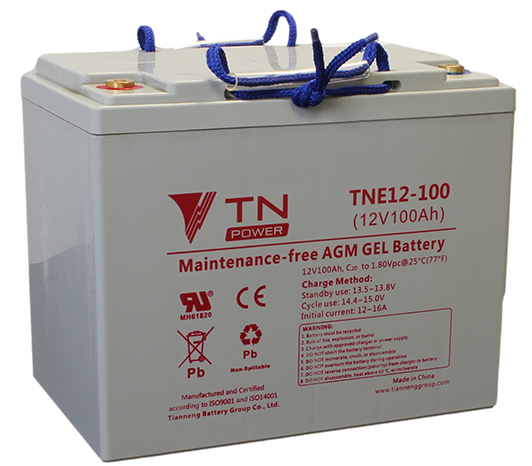 | Battery This is the heart of your 12V system, providing your domestic circuits with power when you're off grid. There are many different types and capacities of battery available but a typical installation might consist of a deep-cycle (also known as a leisure or auxiliary) lead-acid battery with a capacity of around 110Ah. Batteries are also probably the most sensitive part of your 12V system as they need to be well cared for in terms of how you charge and discharge them to keep them in optimum condition and maximise their lifespan. To find out more about leisure batteries, please read our Leisure Battery Guide and see our range of batteries here. | 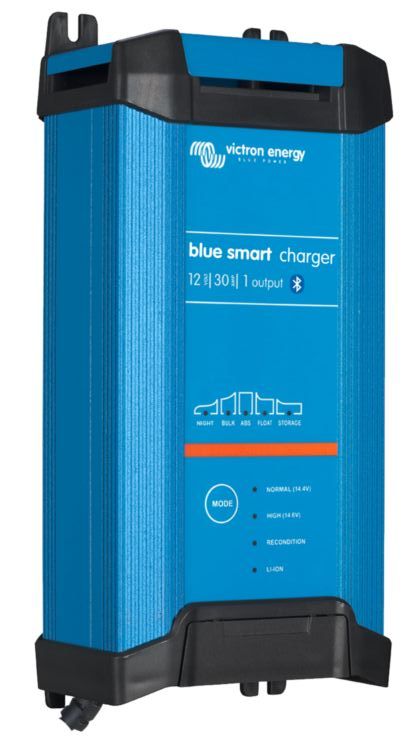 | Mains-powered battery charger These allow you to recharge your battery from a 240V AC supply if you have access to a camp site hook-up or an external socket at home. Typically you would plug into your campsite supply and the charger would automatically begin re-charging your leisure battery, replenishing any charge you may have used during the day whilst allowing you to carry on using your 12V systems. All good quality chargers are now multi-stage, meaning that they will recharge your battery to 100% (assuming the battery is in good condition) and can be left connected indefinitely without damaging the battery. Many chargers are also now able to charge lithium (LiFePO4) as well as lead-acid batteries and some have advanced features such as recovery of 'dead' batteries or the ability to operate as a power supply unit so you can operate your 12V systems without a battery needing to be attached. Chargers are available in various Amp (A) output ratings and the appropriate one for your battery will mostly depend on how much charge the battery can accept. Lead-acid batteries (including wet, AGM & Gel) can typically accept a charge rate up to around 20% of the battery's capacity (i.e. 20A charge output for a 100Ah battery), whereas lithium batteries can accept much higher charge rates if desired (which means a much faster recharge). The initial charge stage will get the battery to around 80% charge level quite quickly, with the remaining 20% usually taking several hours, so a charger is best left on overnight to achieve a full recharge. To see our full range of mains-powered chargers, click here. | 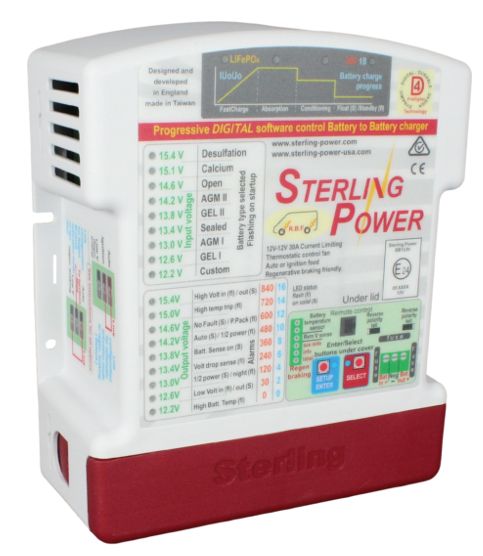 | Alternator-powered battery charger Also known as DC-DC or battery-battery chargers, these perform exactly the same function as mains-powered battery chargers but use the alternator to power them and enable you to re-charge your leisure battery whilst on the move. These have now almost entirely replaced older style split-charging systems which are not compatible with the 'smart' alternators fitted to all modern vehicles. DC-DC chargers are capable of charging any battery type and some even have built-in solar controllers (MPPT type) so you can connect solar panels to them, providing you with another charging source. For our range of DC-DC chargers click here. For our range of DC-DC chargers with built-in MPPT solar controllers click here. For more information on charging from 'smart' alternators, see this article. | | 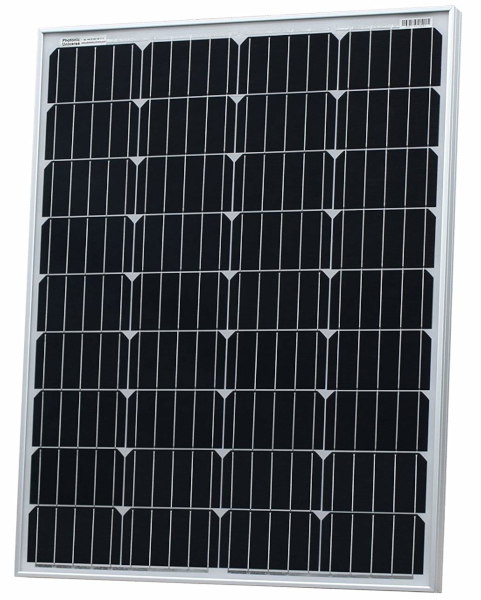
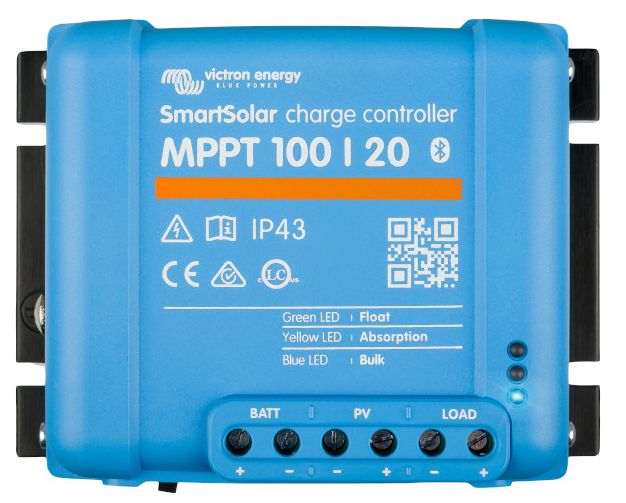
| Solar charging Solar charging systems provide free, environmentally-friendly energy and, whilst not really practical as your main charging source (unless you have a large system or the right weather conditions are guaranteed), are a great backup power source. For example, in a typical setup a medium sized panel of around 120W can be used to support the power demand of a fridge during good daylight conditions, meaning that none of the charge in the battery is used. They are also useful for maintaining your battery to prevent it discharging whilst your vehicle is laid-up. Panels come in rigid, semi-flexible and portable (brief-case style) versions and can be connected together to increase power output. Solar charge controllers (also known as solar regulators) take the power produced by the panel and regulate it to a voltage that is suitable for charging your leisure battery. Most controllers now use MPPT technology, which is very efficient and optimises the use of the power produced by the panel. MPPT controllers are also capable of charging any battery type, including lithium. For our complete range of solar components, click here. | | 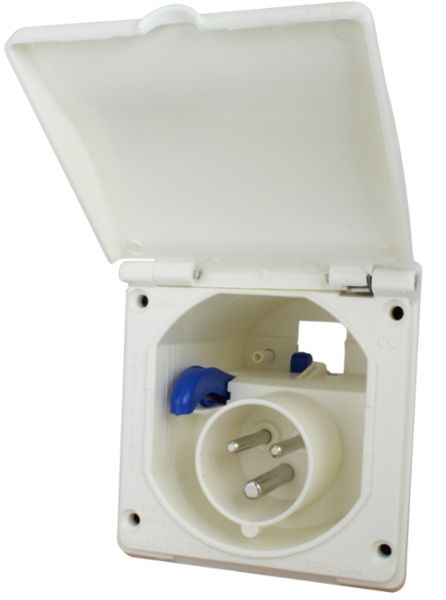
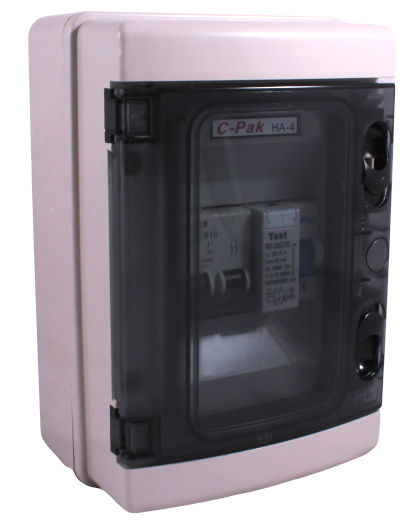
| 240V consumer unit & inlet A 240V consumer unit allows you to safely bring mains power into your vehicle and then plug in and use a range of small 240V appliances, just as you would at home. It contains safety devices, usually one or more circuit breakers and an RCD (residual current device), and will be a smaller version of the consumer unit you have at home. This unit is wired to an waterproof inlet on the outside of your vehicle (flush or surface-mounted versions are available) where you will plug in the 240V site supply. You can then connect 240V appliances to the circuit breakers in the consumer unit. Typical items connected would be a mains-powered battery charger, 3-pin domestic sockets, water heater etc. IMPORTANT: If you are in any doubt when dealing with the 240V side of your installation you should seek help from a qualified professional as the consequences of making a mistake here are much more serious than for 12V DC systems. To view our range of 240V-related products, please click here. | 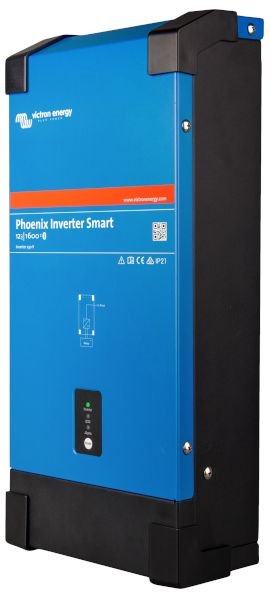 | Inverters Inverters take your 12V DC battery power source and convert it to 240V AC so you can still run mains-powered household items when you don't have access to mains electricity. This can be useful, especially if you plan to be off-grid for extended periods, and allows to you run laptops, TVs, games consoles etc. Inverters are available with various power outputs depending on what you want to run from them and are available either quasi/modified sinewave and pure sinewave versions. Quasi/modified sinewave inverters are less expensive but have limitations compared with pure sinewave inverters. Note of caution: Inverters need carefully specifying to ensure that your equipment will operate and they can drain your leisure battery very quickly if you use them to run a high power item (e.g. heaters, kettles etc.). We recommend sticking to lower power appliances like laptops unless you have a specific requirement and/or a large battery capacity. To view our range of inverters, click here. | 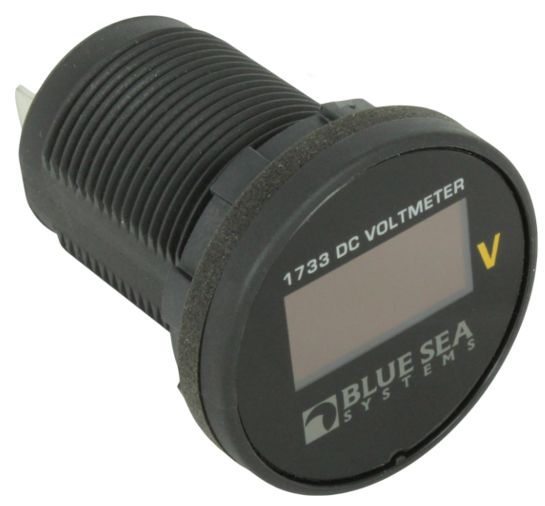 | Voltmeter A voltmeter enables you to get a basic understanding of the state of charge of your leisure battery. A lead-acid battery is typically around 50% discharged when its voltage reaches 12.1V so using a voltmeter you can get a quick and easy indication of when you need to re-charge. They are inexpensive, take up very little space and are perfectly adequate for many basic 12V systems. The disadvantage of a voltmeter is that the voltage measured across the battery terminals (and displayed on the voltmeter) reduces when the battery is powering something and, similarly, increases when it is being charged, so you can only get an accurate reading of the battery voltage by turning off all circuits and charging sources and waiting some time for the battery voltage to stabilise. To see our range of voltmeters, click here. | 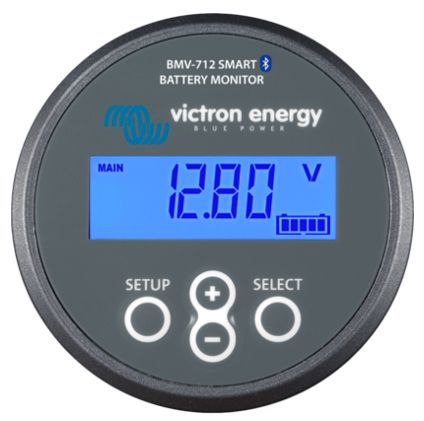 | Battery monitoring system These are much more sophisticated than simple voltmeters and allow you to see the state of charge and health of your battery at any given time. They work by accurately measuring the current flowing into and out of the battery and can offer a range of functions such as % state of charge, time remaining before the battery needs recharging, power consumed/replenished and alarms at high/low voltage levels. Unlike simple voltmeters, you can check your battery status at any time without needing to disconnect loads and charging sources. For our battery monitoring range, click here. | 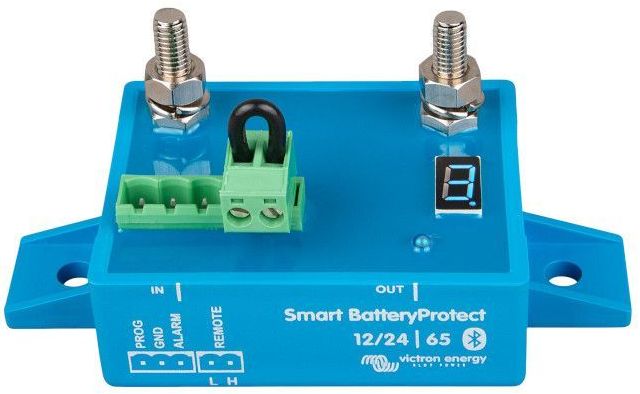 | Battery guards Some types of lead-acid battery can be damaged if discharged too deeply which results in the battery being unable to retain a full charge and the lifespan being reduced (a rule of thumb for lead-acid batteries is not to allow them to be discharged to more than 50% of their capacity). If you've invested a lot of money in a battery or a bank of batteries, then it can make sense to use a battery protection device that automatically disconnects the circuits from the battery when the voltage gets too low, so preventing damaging over-discharge. These are straightforward to fit and setup and give you peace of mind that you're not going to accidentally damage your expensive battery. To see our battery guards, click here. | 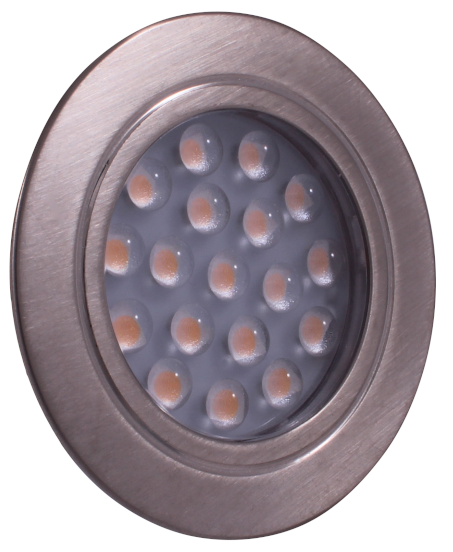 | Lighting All lighting used in vehicles now is based on LED technology as they use far less power than incandescent lights for an equivalent light output. Typical types of lighting used in campervan conversions are ceiling spot lights, wall-mounted reading lights and strip lights (either rigid or flexible strips). More specialist lighting includes step and door entry lights (to illuminate entrances), high power flood/spot lights and scene lights (used to illuminate an area next to the vehicle). To view our full range of LED lights, click here. | | 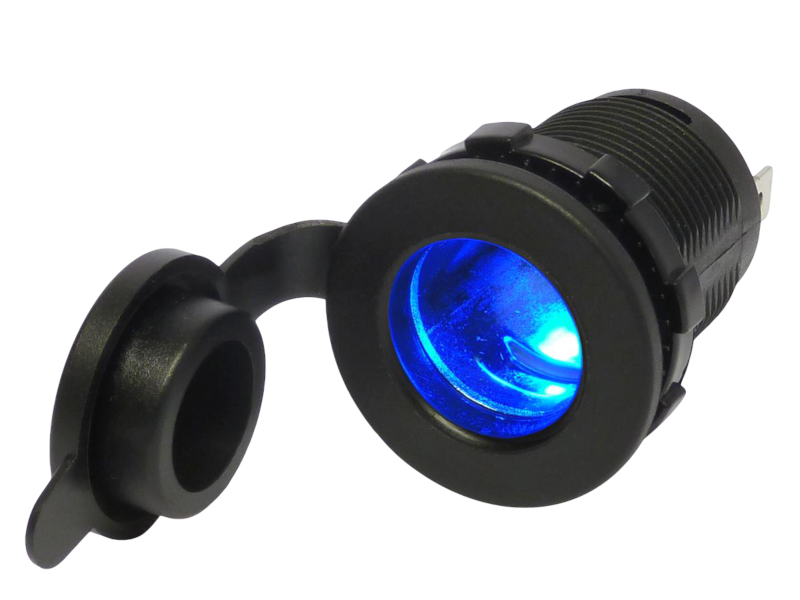
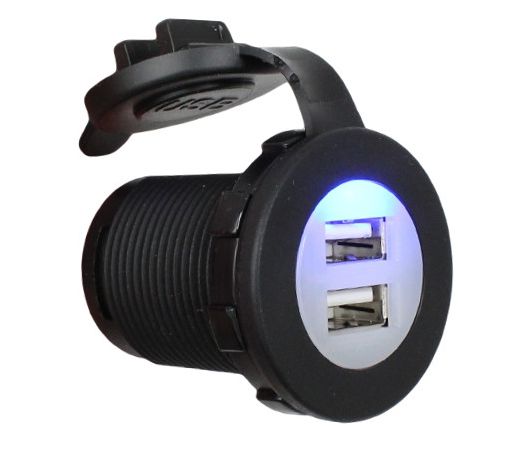
| 12V and USB power sockets These are fitted as standard by most vehicle manufacturers, but there is a vast range of aftermarket versions to choose from when adding more sockets during a conversion. 12V sockets typically handle around 10A max. current and are often used to power coolboxes, 12V TVs, tyre inflators and low-power electronic devices. USB sockets come in various styles and power outputs, with basic versions providing 2.1A to fast charge a single phone or tablet, and higher output versions that can fast charge two devices simultaneously. To view our full range of 12V and USB power sockets, click here. | 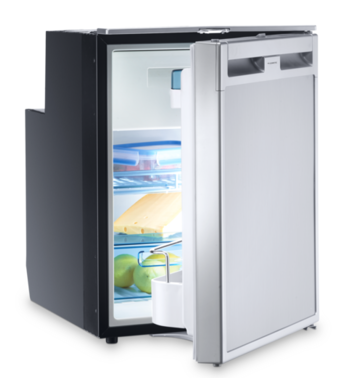 | Fridge or coolbox Often the most critical aspects of a conversion setup, cooling often provides the biggest challenge to a 12V system as it is required 24 hours a day so is a high consumer of power. Plug in, thermoelectric (Peltier effect) cool boxes are relatively inefficient as they only cool to around 20°C below ambient temperature, draw power continuously and are relatively poorly insulated. Compressor fridges are more efficient as they only draw power intermittently (based on a thermostat on/off operation), are well insulated and can cool to much lower temperatures. Care is needed when cabling compressor fridges to ensure excessive voltage drop is avoided. Although much more expensive than thermoelectric cool boxes, we'd always recommend a compressor fridge, if budget allows, because of their superior efficiency and performance. To see our range of fridges, click here. |  | Water pump Water pumps come in various styles from basic, low flow-rate submersible types that sit inside a water container, to high flow rate inline pumps. Typical applications include sink taps and showers. | 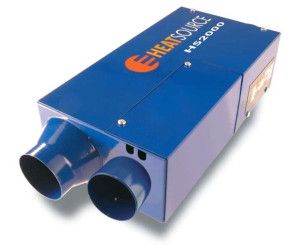 | Propane or diesel heater Great for trips during the winter months, these heaters can run from your gas supply or be plumbed into your vehicle's diesel tank and are compact enough to fit under a seat. They require a 12V electrical supply for the ignition and to run the fan that blows the hot air out, which can draw quite a high current, so they are best used for short periods so as not to drain your battery too much. Most models come with a timer so you can programme them to turn on and off automatically (good for waking up to a warm van!). | 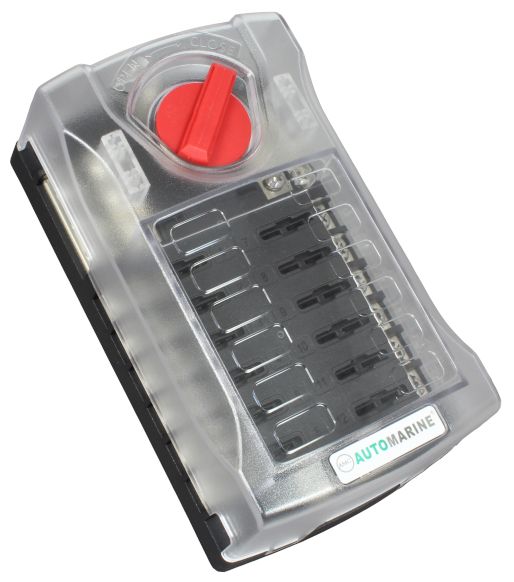 | Fuse box An essential safety item for all installations no matter what size or complexity, a fuse box safely distributes power to each of your circuits and protects the cable from overheating and catching fire if a problem occurs (e.g. short circuit). The most convenient types are those that also have connections for the negative side of each circuit and have common inputs for the battery connections like these. Circuit breakers may be more appropriate in certain applications as they are resettable (whereas a fuse must be replaced) and some types allow for manual disconnection of the circuit for maintenance. | 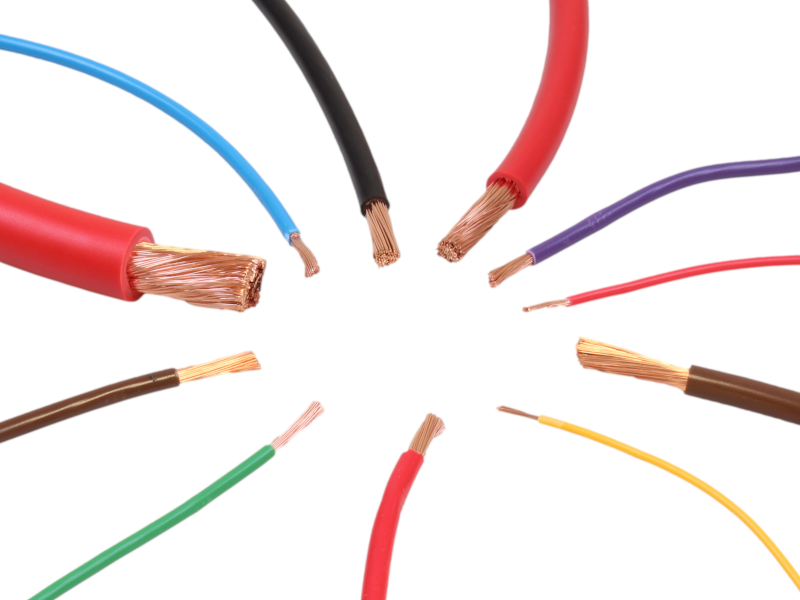 | Cables Cables interconnect all your components and carry electricity throughout your system and it's vital to ensure that the correct size/gauge and type is selected for each circuit so that everything will operate safely and reliably. It's very worthwhile spending some time getting to grips with the basics of cable sizing and selection and we'd recommend taking a look at this article for more info. To see our full range of cable, click here. | 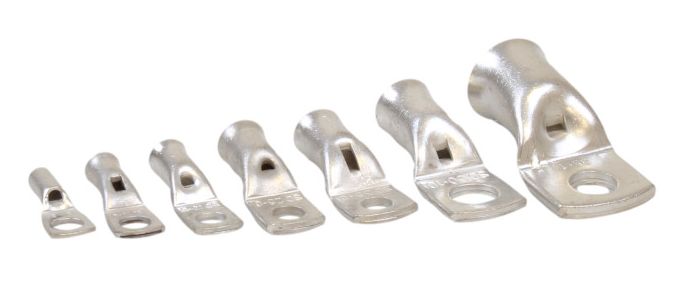 | Terminals & connectors Terminals fit to the ends of bare cable and enable you to connect the cable to all of your equipment and accessories. Available in various styles to suit the cable size and the connection points on your equipment, they are normally crimped (or crimped & soldered) to the cable using hand tools. To view our range of terminals and connectors, click here. | | 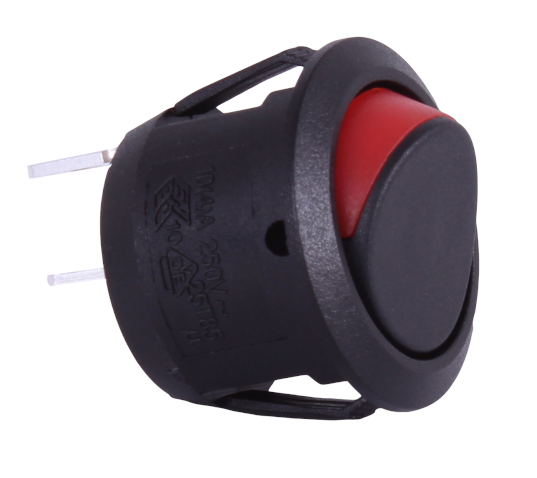
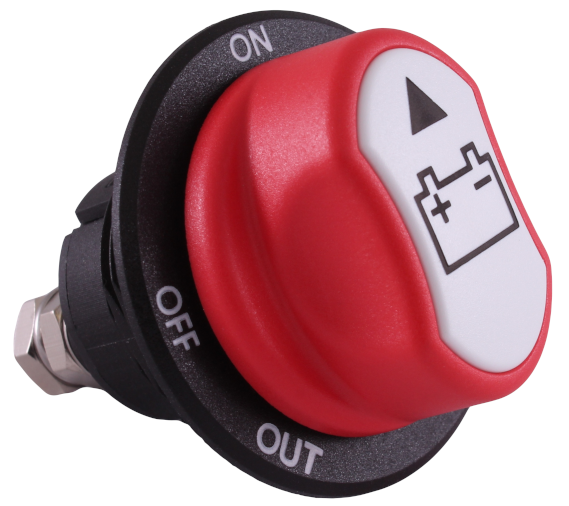
| Switches Some circuits will require switches to turn them on and off and there are a wide variety of styles available. A professional looking solution can be to use a switch panel where all the switches are located in one place, or a modular switch system which allows you to create your own configuration of switches plus power sockets etc. It's also good practice to have an isolation or 'master' switch close to the battery that isolates all of the circuits connected to the battery. This enables you to remove battery power quickly in an emergency or when carrying out work on your electrical system. To view our full range of individual switches (including isolation switches), click here. To view our modular switch systems, click here. To view our switch panel range, click here. | Disclaimer - The information contained in these articles is provided in good faith and we do our best to ensure that it is accurate and up to date, however, we cannot be held responsible for any damage or loss arising from the use or mis-use of this information or from any errors or omissions. The installer is ultimately responsible for the safety of the system so if you are in any doubt, please consult a qualified electrician. |































